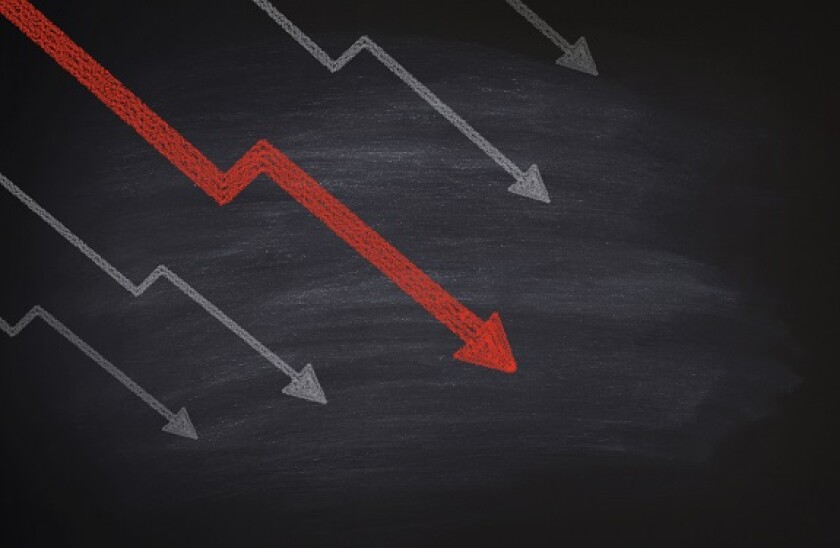China cut the one year benchmark lending rate to 3.85% on Monday morning, 20bp lower than the previous level. The five year LPR was brought down to 4.65%, 10bp lower than last month.
Both cuts were widely expected since the PBoC trimmed the one year medium-term lending facility (MLF) rate by 20bp last Wednesday. The LPR uses the MLF rate as its benchmark. Lower loan rates mean lower borrowing costs for companies.
*
Moody’s has changed its outlook for China’s property sector to negative from stable due to the Covid-19 pandemic and slowing economic growth. It forecasts contracted sales to decline 5% to 10% year-on-year in 2020.
The rating agency reckons most rated high yield developers will be able to address their $92bn in onshore and offshore bond maturity and put through April 2021. This is thanks to broadly stable onshore funding conditions as well as the fact that most developers have pre-funded a large portion of their international debt.
Offshore funding conditions remain uncertain for property developers this year, said Moody’s, citing limited quotas for debt issuance, volatile markets and risk-averse investors.
“Refinancing risk is high, however, for the small developers that have weak liquidity and credit quality,” it added in a report last week.
*
China boosted the death toll number in the city of Wuhan, previously the epicentre of the Covid-19 pandemic, by 50% to 3,869.
Explaining the revision, officials said that at the early stage of the pandemic, there were some delayed, missing or inaccurate data. Some deaths were not included as the patients were not admitted into hospitals due to limited resources at the time, they added.
Apart from adding 1,290 fatalities, Wuhan also added 325 confirmed cases, taking the city's total number of infections to 50,333. The revised number of people discharged from hospitals now stands at 46,335, down from 47,300.
*
Chinese president Xi Jinping chaired a Politburo meeting last Friday, state media Xinhua reported. The government said it will extend more policy support to offset the impact of the Covid-19 pandemic.
“[The Chinese] economy is facing unprecedented challenges,” according to the readout published by Xinhua. China’s GDP shrunk by 6.8% in the first quarter of 2020, the first quarterly contraction since 1992 when the country’s statistics bureau started tracking the number.
The Politburo pledged to adopt proactive fiscal policies, such as higher fiscal deficits and issuing special central government bonds. It also said it will adopt “prudent but flexible” monetary policies, including more cuts in the required reserve ratio (RRR).
The Politburo did not set any explicit annual economic growth targets for 2020. However, in the previous Politburo meeting on March 27, the government said it will strive to achieve the initial annual growth target of about 6%.
*
The PBoC has started testing out China’s digital currency, according to a statement last Friday.
The central bank said that four state-owned banks —Agricultural Bank of China, Bank of China, China Construction Bank and Industrial and Commercial Bank of China — are conducting internal trials for the digital currency. Additionally, the cities of Chengdu, Shenzhen, Suzhou and Xiong’an have been chosen to participate in the trial.
The country’s three state-owned telecom companies — China Telecom, China Mobile and China Unicom — are also involved in the internal test. Internet company Tencent Holdings, the developer of WeChat, participated in the development of the digital currency.
*
The China Securities Regulatory Commission (CSRC) has allowed public funds to invest in China’s over-the-counter National Equities Exchange and Quotations system — also called the New Third Board — for the first time.
However, the funds can only invest in companies belonging to the “selection tier” of the board.
The New Third Board divides listed companies into three tiers: “selection tier”, “innovation tier” and “base tier”. Companies on the “selection tier” are typically those with a longer operating history and that ready to move to the main board or the Shanghai Star board.
*
Both the CSRC and the PBoC have published working plans for 2020.
Notably, the central bank said it will set new regulations on financial holdings firms, the issuance and trading of asset-backed securities and the implementation of total loss-absorbing capacity requirements for China’s global systemically important banks.
The CSRC said it will update rules regarding the ChiNext board’s registration system and publish new rules on the securities and futures market.
*
The Chinese foreign minister, Wang Yi, held a call with the director general of the World Health Organization, Tedros Adhanom Ghebreyesus.
According to an update on the Foreign Ministry’s website, Wang reiterated China’s support for the WHO. He said there was no factual evidence backing the attacks on the organisation, and any pressure and coercion are unpopular. Any country with a conscience will not support such actions, Wang said.
The remarks came just days after US president Donald Trump accused the WHO of being biased towards China in its handling of the pandemic and said he will halt funding to the organisation.
